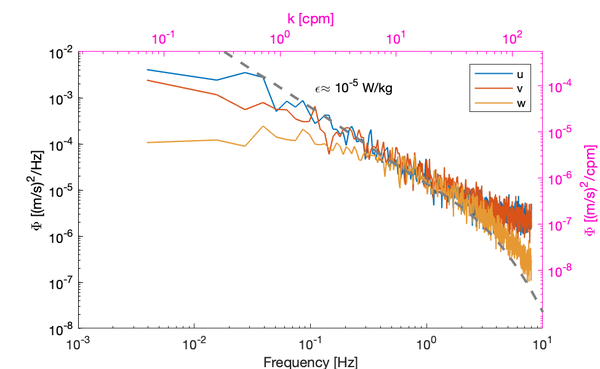Velocity inertial subrange model
| Short definition of Velocity inertial subrange model |
|---|
| The inertial subrange separates the energy-containing production range from the viscous dissipation range. |
This is the common definition for Velocity inertial subrange model, but other definitions maybe discussed within the wiki.
{{#default_form:DefineConcept}} {{#arraymap:Velocity point-measurements, Velocity profilers|,|x||}}
Model for steady-flows
This theoretical model predicts the spectral shape of velocities in wavenumber space.
<math>\Psi_{Vj}(\hat{k})=a_jC_k\varepsilon^{2/3}\hat{k}^{-5/3}</math>

Here <math>\hat{k}</math> is expressed in rad/m and <math>Vj</math> represents the velocities <math>V</math> in direction <math>j</math>. <math>C_k</math> is the empirical Kolmogorov universal constant of C = 1.5 [1]. Amongst the three direction, the spectra deviates by the constant <math>a_j</math>: [2]
- In the longitudinal direction, i.e., the direction of mean advection (j=1), <math>a_1=\frac{18}{55}</math>
- In the other directions <math>a_2=a_3=\frac{4}{3}a_1</math>
Models influenced by surface waves
Need to add equations and figures from Lumley & Terray[3]
Inertial subrange collapse and anisotropy
Near boundaries or low energy environments--defined as flows with a small separation between the large turbulent overturns <math>L</math> and the smallest (Kolmogorov)-- tends to adversely impact our ability to estimate <math>\varepsilon</math> from the lower wavenumbers. In certain cases, the velocity spectra may not have a sufficiently developed inertial subrange to estimate <math>\varepsilon</math> [4][5].

Notes
- ↑ {{#arraymap:K. R. Sreenivasan|,|x|x|, |and}}. 1995. On the universality of the Kolmogorov constant. Phys. Fluids. doi:10.1063/1.868656
- ↑ {{#arraymap:S.B Pope|,|x|x|, |and}}. 2000. Turbulent flows. Cambridge Univ. Press. doi:10.1017/CBO9780511840531
- ↑ {{#arraymap:J. Lumley and E. Terray|,|x|x|, |and}}. 1983. Kinematics of turbulence convected by a random wave field. J. Phys. Oceanogr. doi:<2000:KOTCBA>2.0.CO;2 10.1175/1520-0485(1983)<2000:KOTCBA>2.0.CO;2
- ↑ {{#arraymap:A. E. Gargett, T. R. Osborn, and P.W. Nasmyth|,|x|x|, |and}}. 1984. Local isotropy and the decay of turbulence in a stratified fluid. J. Fluid. Mech.. doi:10.1017/S0022112084001592
- ↑ 5.0 5.1 {{#arraymap:C.E. Bluteau, N.L. Jones, and G. Ivey|,|x|x|, |and}}. 2011. Estimating turbulent kinetic energy dissipation using the inertial subrange method in environmental flows. Limnol. Oceanogr.: Methods. doi:10:4319/lom.2011.9.302
